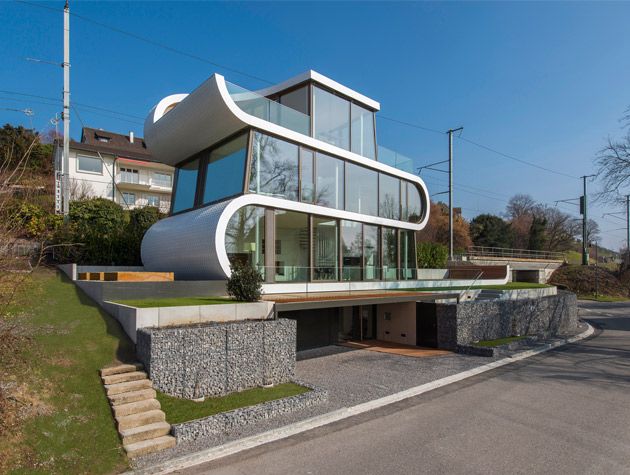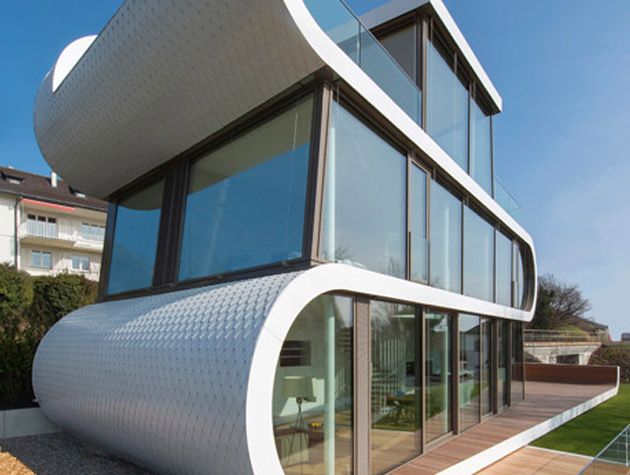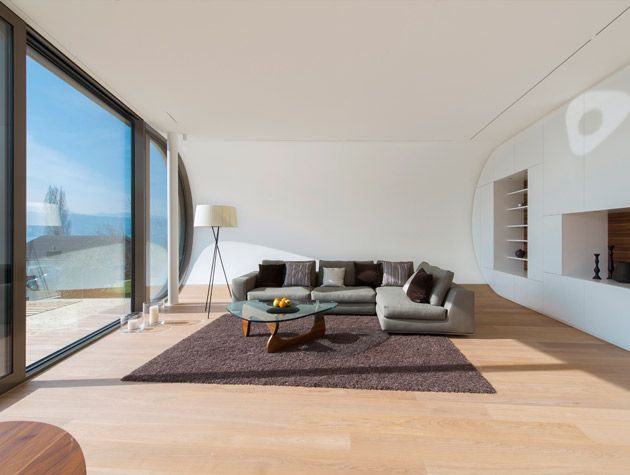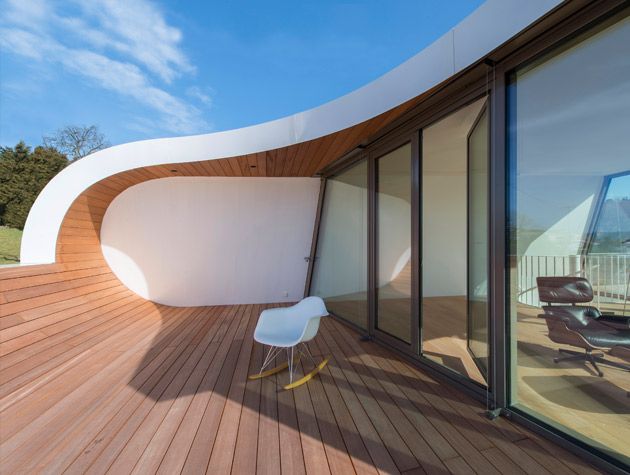Curved house on Lake Zürich, Switzerland
Stefan Camenzind had to think outside the box - literally - to create his remarkable curved home on Lake Zürich
Stefan Camenzind had to think outside the box – literally – to create his remarkable curved home ‘Flexhouse’ on Lake Zürich, Switzerland.
‘When you finish a project like Flexhouse, you realise why most buildings are square boxes,’ laughs Evolution Design’s executive director, Stefan Camenzind, on the subject of the curvy, undulating house that he has designed and built for his family on the shores of Lake Zürich in Switzerland.
‘The building industry operates in squares, not curves and odd angles or unusual shapes. Anything that isn’t a box is difficult, so in a building like this, there’s an endless amount of work to maintain the concept and make it look effortless.’

Photo: Peter Wuermli
Stefan’s approach to Flexhouse was not some kind of protracted exercise in design masochism, however. It was, according to the architect, a site-specific response to what was essentially a tricky, trapezium-shaped sliver of land squeezed between a railway line and a low-lying road.
‘Finding an affordable plot next to Lake Zürich is not an easy task – it’s almost impossible, in fact – so I began to look for ones that looked like you couldn’t build on them,’ explains Stefan. ‘This is such a challenging site – it tapers to nothing. As a result, I was able to negotiate an affordable price. Land that would be easier to build on would have cost three to four times as much.’
Strict Swiss building regulations and rules around boundary distance and structure size were also major factors that would have to be considered in the design. ‘My team at Evolution Design and I were determined to create something that responded to the site, rather than just a square thing planted on the ground,’ says Stefan. The outside-the-box response was to take the railway line, road and lake beyond as inspiration.

Photo: Peter Wuermli
‘We wanted to make the building all about movement,’ says Stefan, ‘so we designed terraced layers that roll down to the lake. We also created a flow through the building with the external curves that form a beautiful backdrop inside. The interiors are characterised by smooth spaces with no hard edges.’
This, combined with the boundary barrier to the railway and the protective, solid, back wall, creates a much more nurturing human environment for the couple.
This fluidity continues indoors, both in the open-plan living areas and in the seamless transition between levels. Instead of closed-off individual floors, double-height spaces offer glimpses of rooms above and below.

Photo: Peter Wuermli
The north-facing rear wall of Flexhouse has many functions: in the living room, it provides a place for a storage and display space, and it’s the element the kitchen extends from, while the south-facing front wall is given over entirely to glazing.
‘Inside, you can feel the flow and direction of the building, and enjoy the movement of the light throughout the day,’ says Stefan.
Architecturally, the building that finally emerged in March 2016 is a four-storey, 173 square metre house, characterised by curving insulated timber panels clad in aluminium shingles, snaking through to form the walls, while drawing the eye continuously upwards. Edge-blurring glass walls on three sides offer 180° views across Lake Zürich to the mountains beyond.

Photo: Peter Wuermli
The home appears to sit lightly and easily on the ground, but this is far from the whole story.
‘Structurally, the building was a challenge,’ admits Stefan in something of an understatement. ‘In order to utilise as much of the site as possible, we asked if we could build closer to the railway line than we would normally be allowed and we were given special permission. This meant that we had to be extremely careful when we were building down into the basement to protect against any movement. And, in order to root the house, we needed huge steel anchors set almost 20 metres down into the hillside, which was expensive and time consuming.’

Photo: Peter Wuermli
Stefan concedes that this effort and cost was essential to the overall success of the structure. ‘Buildings shouldn’t reflect the challenges involved, they should look effortless, as if they slipped into life without a hitch. I wanted to create this impression and make sure it didn’t reflect the trouble it took to create.’
Some elements were a lot more difficult than others. ‘Due to the unusual shape of the house, a lot of the triple-glazed units, doors and external sunshades are not standard square or rectangular sizes. Many of these details looked easy to execute on the drawings, but later became a case of “how do I solve this?”,’ says Stefan.
‘This was a challenge technically and we had to experiment a bit with the standard shapes of things. Anything that didn’t come off the shelf obviously cost a bit more to be customised, but in many other respects construction was simplified.’

Photo: Peter Wuermli
The concrete slabs that comprise the floors have built-in pipes directly connected to a geothermal heat pump, rather than the traditional multiple layers of cement, screed, acoustic insulation and underfloor heating. Having just one thermally activated slab with parquet flooring on top helped save on construction costs.
‘The shingle cladding for the prefabricated insulated timber panels is fortunately a standard product,’ says Stefan. ‘Aluminium is an easy solution, as you can shape it to any form. It also has a lovely texture, it’s very tactile, which fits into the idea of a more human home than a glossy, streamlined building.’

Photo: Peter Wuermli
Indeed, Stefan asserts that Flexhouse is the antithesis of slick. ‘A common misconception about the house is that it doesn’t have a lot of privacy, but it’s not like that living here at all. There are external blinds to regulate the heat and light, as well as internal curtain tracks. This gives us the choice to create a space that’s either akin to climbing a mountain to take advantage of the views or sitting inside a cosy pub in front of a fire. These contrasting experiences can both be created in one space.
‘When you’re inside, it’s such a calm building,’ concludes Stefan. ‘It takes you down a few notches. Many houses start off as barren boxes that need to be decorated to be liveable and comfortable. Flexhouse in Switzerland is a naturally relaxing space without any additions.









